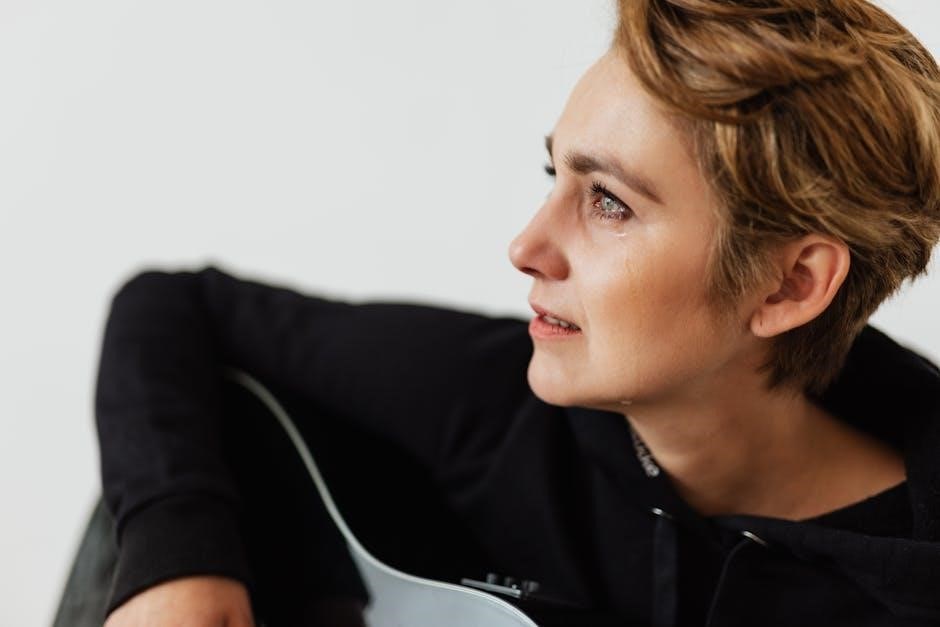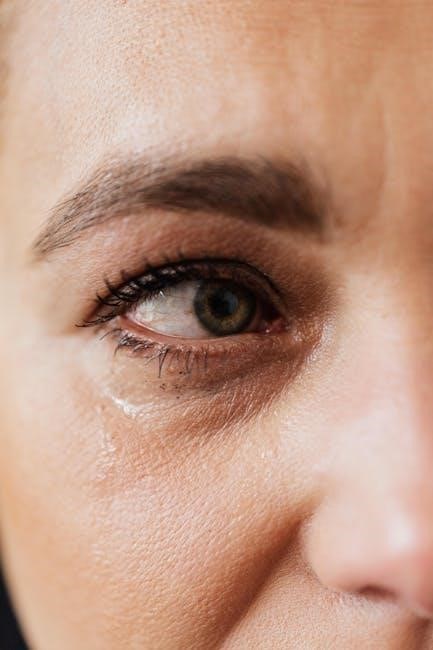A structured rehabilitation program for SLAP tear recovery is often detailed in downloadable PDF guides․ These resources outline progressive exercises to reduce pain‚ enhance mobility‚ and strengthen shoulder muscles‚ promoting a full recovery․
1․1 Overview of SLAP Tears and Their Impact on Shoulder Function
A SLAP tear is an injury to the superior labrum of the shoulder‚ often caused by trauma or repetitive motion‚ impacting the labrum’s ability to stabilize the joint․ This injury can significantly limit shoulder mobility and strength‚ affecting activities like throwing or lifting․ The labrum‚ a cartilage ring surrounding the shoulder socket‚ plays a crucial role in maintaining joint stability and facilitating smooth movement․ A Type II SLAP tear‚ the most common type‚ involves the detachment of the biceps anchor from the glenoid‚ further compromising shoulder function․ If left untreated‚ SLAP tears can lead to chronic pain‚ decreased performance in sports‚ and increased risk of further shoulder damage․ Early diagnosis and appropriate management are essential to restore function and prevent long-term complications․
1․2 Importance of Exercise in Non-Surgical and Post-Surgical Recovery
Exercise plays a pivotal role in both non-surgical and post-surgical SLAP tear recovery․ It helps restore shoulder mobility‚ strength‚ and stability‚ reducing pain and improving function․ For non-surgical cases‚ a structured exercise program focusing on scapular stabilization and rotator cuff strengthening can prevent progression and avoid surgery․ Post-surgically‚ exercises are tailored to protect the repair while gradually reintroducing movement and strength․ Early mobilization and controlled loading of tissues promote healing and prevent stiffness․ Compliance with a supervised or home-based rehabilitation plan is crucial for achieving pre-injury function‚ especially in athletes aiming to return to sports․ Consistent progression through exercises ensures a balanced recovery‚ minimizing the risk of recurrence and enhancing overall shoulder health․

Phases of SLAP Tear Rehabilitation
SLAP tear rehabilitation follows a structured‚ progressive program divided into four phases․ Each phase focuses on specific goals‚ such as pain management‚ strength‚ mobility‚ and functional return‚ ensuring a gradual recovery․
2․1 Phase I: Protection and Pain Management (0-4 Weeks)
Phase I focuses on protecting the injured shoulder and managing pain․ Patients are advised to wear a sling full-time except during prescribed exercises․ Passive and active-assistive range of motion exercises‚ such as shoulder pendulum swings and gentle rotations‚ are initiated to prevent stiffness․ Isometric strengthening exercises for the rotator cuff and scapular stabilizers are also introduced to maintain muscle activity without putting stress on the injury․ Pain management modalities like ice‚ heat‚ and electrical stimulation are commonly used․ The primary goal is to create an environment conducive to healing while minimizing discomfort and maintaining basic shoulder function․
2․2 Phase II: Strengthening and Mobility (4-8 Weeks)
Phase II emphasizes strengthening and improving mobility․ Patients progress to active range of motion exercises‚ such as arm circles‚ shoulder flexion‚ and external rotations‚ often with light resistance bands․ Scapular stabilization exercises‚ like wall slides and scapular push-ups‚ are prioritized to enhance shoulder stability․ Strengthening of the rotator cuff and biceps is introduced with low-resistance exercises․ Dynamic stability drills‚ such as medicine ball tosses‚ are incorporated to improve functional movement․ Pain-free PROM is expected by week 4‚ with AROM achieved by week 8․ This phase focuses on rebuilding strength and restoring normal shoulder mechanics‚ preparing the patient for more advanced activities in subsequent phases․
2․3 Phase III: Advanced Strengthening and Functional Activities (8-12 Weeks)

Phase III focuses on advanced strengthening and functional activities․ Patients progress to higher-resistance exercises‚ such as resisted external rotations and internal rotations‚ using bands or light weights․ Dynamic stability drills‚ like plyometric exercises and dynamic control tasks‚ are introduced to enhance shoulder power and endurance․ Sport-specific or job-related movements are incorporated to mimic real-life activities‚ ensuring a smooth transition to full functionality․ Emphasis is placed on improving neuromuscular control and proprioception through advanced scapular and rotator cuff exercises․ Patients are encouraged to gradually increase resistance and intensity‚ preparing for unrestricted movement and return to pre-injury activities․ This phase bridges the gap between rehabilitation and independent functional recovery‚ ensuring long-term shoulder stability and strength․
2․4 Phase IV: Return to Full Activity
Phase IV marks the transition to full activity‚ focusing on unrestricted participation in sports‚ work‚ or daily activities․ Patients gradually resume pre-injury activities under controlled conditions‚ ensuring the shoulder can handle demands without pain or instability․ Advanced drills‚ such as sport-specific movements and high-level functional tasks‚ are emphasized to restore peak performance․ Strengthening exercises are continued to maintain muscle balance and endurance․ The physical therapist tailors the program to address specific needs‚ ensuring the shoulder is robust and stable․ This phase concludes with a comprehensive assessment of strength‚ range of motion‚ and functional ability‚ confirming readiness for unrestricted activity․ The goal is to achieve long-term durability and prevent future injuries‚ allowing patients to return to their normal lifestyles confidently․

Specific Exercises for SLAP Tear Recovery
Exercises focus on scapular stabilization‚ rotator cuff strengthening‚ and bicep/labrum-focused movements․ These exercises enhance shoulder stability‚ strength‚ and mobility‚ aiding in a comprehensive recovery process․
3․1 Scapular Stabilization Exercises
Scapular stabilization exercises are crucial for restoring shoulder function after a SLAP tear․ These exercises target the muscles around the scapula‚ such as the trapezius‚ rhomboids‚ and serratus anterior‚ improving posture and reducing strain on the labrum․ Common exercises include wall slides‚ scapular push-ups‚ and prone exercises like the “I” and “T” formations․ Resistance bands or light weights can be incorporated to enhance strength․ Proper form and controlled movements are essential to avoid aggravating the injury․ Stabilization exercises also improve scapulohumeral rhythm‚ ensuring smooth shoulder joint mechanics․ Regular practice helps prevent compensatory movements and promotes long-term shoulder stability‚ making these exercises a cornerstone of SLAP tear rehabilitation programs․
3․2 Rotator Cuff Strengthening Exercises
Rotator cuff strengthening exercises are vital for restoring shoulder function after a SLAP tear․ These exercises target the four muscles of the rotator cuff (supraspinatus‚ infraspinatus‚ teres minor‚ and subscapularis)‚ which stabilize the shoulder joint․ Common exercises include shoulder external rotations‚ internal rotations‚ and scapular wall slides․ Resistance bands or light weights are often used to gradually increase strength․ Performing these exercises with proper form ensures the rotator cuff muscles function optimally‚ reducing strain on the labrum․ Progression to more advanced exercises‚ such as cable rotations or medicine ball tosses‚ is based on strength and pain tolerance․ Strengthening the rotator cuff is essential for achieving long-term shoulder stability and preventing future injuries‚ making it a key component of SLAP tear rehabilitation programs․
3․3 Bicep and Labrum-Focused Exercises
Bicep and labrum-focused exercises are designed to protect the labral repair while strengthening the biceps tendon․ Gentle bicep curls with light resistance are introduced after the initial healing phase‚ ensuring minimal stress on the labrum․ Modified exercises like isometric bicep contractions and prone forearm curls are often recommended․ Scapular stabilization is emphasized to prevent compensatory movements․ Avoiding heavy lifting or overhead activities is crucial during early recovery․ These exercises gradually restore bicep function without compromising the labral repair‚ promoting a balanced recovery process and reducing the risk of re-injury․ Proper progression ensures the shoulder regains strength and stability‚ allowing for a safe return to functional activities and sports․
Pain Management and Modalities
Pain management for SLAP tears often includes ice‚ heat‚ and electrical stimulation to reduce inflammation․ Gentle exercises and activity modification help minimize discomfort while promoting healing and recovery․
4․1 Managing Pain Through Exercise and Activity Modification
Managing pain through tailored exercises and activity modification is crucial for SLAP tear recovery․ Gentle movements‚ such as shoulder pendulum exercises and passive range-of-motion activities‚ help reduce stiffness without exacerbating symptoms․ Avoiding heavy lifting‚ overhead movements‚ and repetitive actions minimizes strain on the labrum․ Strengthening exercises for the rotator cuff and scapular stabilizers improve joint support‚ reducing pain over time; Activity modification ensures patients avoid aggravating movements‚ allowing the labrum to heal properly․ This balanced approach promotes pain relief while fostering gradual return to normal function‚ emphasizing the importance of adhering to a structured rehabilitation plan tailored to individual needs and progress․
4․2 Use of Ice‚ Heat‚ and Electrical Stimulation
The use of ice‚ heat‚ and electrical stimulation is a common approach to manage pain and inflammation during SLAP tear rehabilitation․ Ice therapy helps reduce swelling and numbs the area‚ typically applied for 15-20 minutes several times a day․ Heat therapy‚ such as warm compresses or showers‚ can relax tight muscles and improve circulation‚ often used after the initial inflammatory phase․ Electrical stimulation‚ including TENS or NMES‚ may be prescribed to alleviate pain and promote muscle activation without overloading the shoulder․ These modalities complement exercise programs‚ enhancing comfort and recovery․ Proper application and timing are essential to maximize benefits and avoid complications‚ ensuring a safe and effective rehabilitation process tailored to individual patient needs and progress․

Avoiding Aggravating Activities
Avoiding movements that exacerbate symptoms‚ such as overhead throwing or heavy lifting‚ is crucial during recovery․ Activities involving repetitive arm motions or across-the-body reaching should be minimized to prevent further injury and ensure proper healing of the labrum and surrounding tissues․
5․1 Identifying and Avoiding Movements That Exacerbate Symptoms
Identifying movements that worsen SLAP tear symptoms is critical for effective recovery; Overhead activities‚ heavy lifting‚ and repetitive arm motions across the body often aggravate the injury․ Avoiding these movements helps prevent further strain on the labrum and biceps complex․ Patients should refrain from actions that involve throwing‚ reaching‚ or lifting weights‚ as these can delay healing․ Modifying daily activities and exercises to eliminate provocative motions is essential․ Consulting with a physical therapist can help identify specific triggers and develop alternative movements to maintain mobility without causing discomfort․ By minimizing aggravating activities‚ individuals can protect their shoulder and promote a safer‚ more efficient recovery process․
